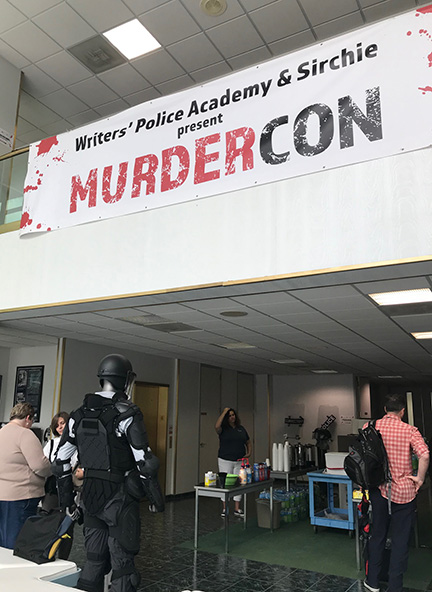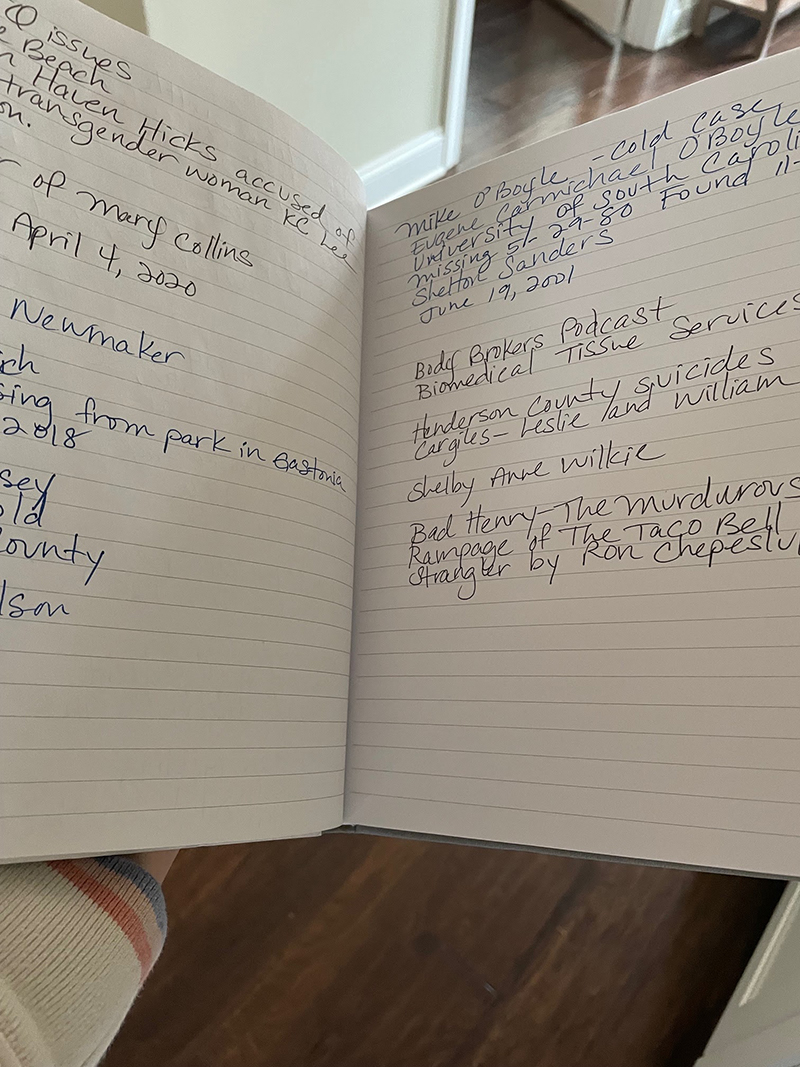
here was a time when true crime writing was limited to the mass market paperbacks by authors such as Ann Rule and Joe McGinnis, specialized publications like True Detective (which ceased publication in 1995), or shared through visual storytelling like television “movies of the week.” But over the last decade, more opportunities have appeared for writers interested in the genre.
I began reading those mass market paperbacks in high school, where I learned about the chilling crimes of Charles Manson and his followers and serial killers like Ted Bundy. Because I had read about Diane Downs and her attempt to murder all of her children and blame it on a carjacker, I immediately knew South Carolina mom Susan Smith was lying when I saw her interviewed on a local news station in 1994. But although I was trained as a journalist, I never imagined I would one day find myself writing true crime and becoming what some would consider an expert in the subject matter.
What is True Crime?
True crime is a nonfiction genre of popular media that concerns real-life crimes. A work can focus on either a single case, such as a disappearance, murder, or sexual assault, or the collective acts of a single criminal, such as a serial killer. This genre places emphasis on a timeline of events and presentation of facts.
Hallmarks of a compelling true crime story can include excellent research, attention to detail, a chronological timeline the reader will be able to follow easily, a twist the reader did not see coming, the exploration of how a cold case was solved, and the determination involved (by law enforcement, a victim, or victim’s family members) in solving a case.
Paving My Own Path

Like many others, I began listening to podcasts several years ago, and true crime became my favorite genre. After attending MurderCon, a writing conference designed for writers interested in crime, I toyed with the idea of developing my own regional podcast focusing on missing people from North and South Carolina, which is the area where I live. Research included listening to other podcasts to get an idea of format. I made a list of unsolved cases that interested me. I wanted a podcast that focused more on the facts of the disappearances while also using unique storytelling methods.
Writing those first few scripts was an arduous process. I watched news segments and read any true crime articles and books I could find to learn different ways of presenting the information. Over time I began reaching out to other writers in the field to feature on the podcast and the show has evolved to feature regional crimes along with missing people. I interviewed the authors of Deceit, Disappearance & Death on Hilton Head Island to put together a two-part episode on the mystery of what happened to Liz and John Calvert from South Carolina in 2008.
Over time, I branched out and even secured an interview with true crime writer Leslie Rule, daughter of the prolific Ann Rule, and she shared tips for writing and researching true crime ethically in an article for WOW.
I launched the podcast in March 2020 and am about to release my 100th episode. By building this platform for myself, I’ve been able to meet some amazing authors, mentor other true crime writers and podcasters, create digital courses, and help breathe new life into cold cases.
Where I Share My Work
I’ve had a writing blog for years, and after I began posting short articles pulled from my true crime research, I realized there are some cases that lack a digital footprint. I’ve received e-mails and comments from people connected to the cases, retired law enforcement, and even other authors looking for additional information. One post I shared about a cold case from my university has garnered attention from a fellow alumnus who recently secured a book deal about the murder. We connected, and he shared information with me I used in a podcast episode, and in return, I’ve given him resources he didn’t know existed for his book project. While I have a separate website for my podcast, Missing in the Carolinas, I pull snippets from my podcast scripts and share them on my writing blog. I believe sharing my work in these different places has helped me build a platform in the true crime genre.
Finding Ideas

As a person who enjoys walking and jogging outdoors, I remembered a kidnap/murder case of a female runner that happened when I was in college. I then put together an entire episode titled “Missing Runners in North Carolina.” After becoming acquainted with a local professor and historian in my area, I interviewed him for an October episode that featured the oldest unsolved murder in our area.
Many times, I’ll be immersed in the news archives, and another headline will catch my eye. When this happens, I jot down the idea in a notebook I keep specifically for true crime ideas. This has led me to sharing stories about crimes that have virtually no digital footprint, such as the murders of Lucille Rinaldi and Brenda Anderson, who were allegedly murdered by their husbands in the 1960s for insurance money.
Research Methods
My research methods have helped me produce thorough examinations of crimes and missing persons cases. Here are a few resources I recommend when putting together a detailed timeline of a crime. (All fees are accurate at time of article publication.):
Newspapers.comTM is the largest online newspaper archive consisting of 933 million-plus pages of historical newspapers from 25,100-plus newspapers from around the United States and beyond. A monthly subscription is $74.90 every six months.
Leagle.com is a resource for publicly available court documents.
The FBI Vault is the FBI’s new Freedom of Information Act (FOIA) Library, containing 6,700 documents and other media that have been scanned from paper into digital copies, so you can read them in the comfort of your home or office.
Scribd is a digital document library, with more than 170 million documents and counting. You can find and upload text on a variety of topics and niches, including true crime, for the monthly subscription of $11.99.
InternetArchive.org is free to use. The 501(c)(3) nonprofit is building a digital library of internet sites and other cultural artifacts in digital form. Like a paper library, they provide free access to researchers, historians, scholars, people with print disabilities, and the general public. Today it features twenty-eight-plus years of web history accessible through the Wayback Machine.
Since 1967, the FOIA has provided the public the right to request access to records from any federal agency. It is often described as the law that keeps citizens in the know about their government. Federal agencies are required to disclose any information requested under the FOIA unless it falls under one of nine exemptions, which protect interests such as personal privacy, national security, and law enforcement. An FOIA request must be in writing. Most federal agencies now accept FOIA requests electronically, including by web form or e-mail. There are exemptions to these requests, and you can find more information from FOIA.gov.
True Crime Markets
Regional newspapers and magazines are a great place to pitch your work, especially if you are a local writer or have a tie-in that makes sense for the publication. Consumer magazines such as Texas Monthly, Outside, People, Cosmopolitan, Vanity Fair, and Atlantic Monthly also publish true crime articles. Duotrope, a searchable markets database, has current listings for journals, magazines to pitch, and book publishers. Black Rose Writing, WildBlue Press, and Arcadia Publishing are seeking proposals for nonfiction and true crime books.
The digital magazine Truly Adventurous pays up to $1,000 for longform articles that include true crime and real-life mysteries, and they were featured in the June WOW! Markets newsletter.
Atavist is another digital storytelling publication that publishes longform narratives, many focused on true crime. They pay authors a baseline of $6,000 per story as well as quarterly royalty fees based on traffic and paywalled versions of their stories. The WOW! Markets Newsletter has featured their calls, and you can find their submission guidelines here.
Because true crime is so popular, there are numerous YouTube Channels and podcasts in the works related to the genre. I often see listings for writers and editors on Fiverr and Upwork.
Take Caution When Writing and Researching
Ethical true crime stories are the ones that focus on victims and don’t center the criminal as some cult of personality or mysterious mind to untangle. It’s important to have reverence for the victim or victims when writing true crime.
The popularity of true crime has given rise to the popularity of “citizen sleuths,” fans who frequent social media platforms like Reddit or Tik Tok. These sleuths enjoy discussing ongoing cases, but sometimes they take their sleuthing too far, discussing suspects that haven’t been confirmed by law enforcement, or worse, encouraging people to harass suspects or family members of victims online. In some instances, true crime content isn’t respectful of the victims and reduces the victims to memes or commodities and merchandise.
Fiction Inspired by Real-Life Stories
Much of my fiction stories have been inspired by real-life crime. The unsolved missing person case of Tara Calico from New Mexico was the impetus for “The Polaroid.” I used the setting of the Oklahoma Girl Scout murders as the framework for “The Monster in the Woods.” I wrote the first draft of “The Last Circus” after visiting the Ringling Museum in Sarasota and reading about the circus fire of 1944. “In the Depths” was inspired by a highly-publicized case from my area of North Carolina.
Other writers have done the same. The young adult novel by Lauren Oliver, Broken Things, was inspired by the Slenderman stabbing. Emma Cline set her novel The Girls in 1960s Northern Carolina to explore the activities of a Charles Manson-like cult.
*
Don’t be intimidated when writing true crime. Be as creative as you want while still sticking to the facts.
Five years ago, I was working as a regional magazine editor and only dreaming about writing true crime. Then I took the leap, and I now have enough content written about crime in North and South Carolina that I’m considering self-publishing my podcast scripts in a book format. Not only that, I have built an incredible network of advocates, historians, listeners, and other writers.
***

Renee Roberson is an award-winning writer who lives in the Lake Norman area of North Carolina. She produces the weekly true crime podcast Missing in the Carolinas and is currently seeking representation for her suspense/thriller novel about—what else—a podcaster trying to solve the disappearance of her sister. Learn more at FinishedPages.com.